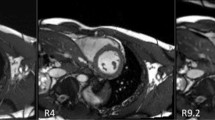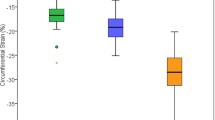Abstract
Purpose
Functional strain is one of the important clinical indicators for the quantification of heart performance and the early detection of cardiovascular diseases, and functional strain parameters are used to aid therapeutic decisions and follow-up evaluations after cardiac surgery. A comprehensive framework for deriving functional strain parameters at the endocardium, epicardium, and mid-wall of the left ventricle (LV) from conventional cine MRI data was developed and tested.
Methods
Cine data were collected using short TR-/TE-balanced steady-state free precession acquisitions on a 1.5T Siemens Espree scanner. The LV wall borders are segmented using a level set-based deformable model guided by a stochastic force derived from a second-order Markov–Gibbs random field model that accounts for the object shape and appearance features. Then, the mid-wall of the segmented LV is determined based on estimating the centerline between the endocardium and epicardium of the LV. Finally, a geometrical Laplace-based method is proposed to track corresponding points on successive myocardial contours throughout the cardiac cycle in order to characterize the strain evolutions. The method was tested using simulated phantom images with predefined point locations of the LV wall throughout the cardiac cycle. The method was tested on 30 in vivo datasets to evaluate the feasibility of the proposed framework to index functional strain parameters.
Results
The cine MRI-based model agreed with the ground truth for functional metrics to within 0.30 % for indexing the peak systolic strain change and 0.29 % (per unit time) for indexing systolic and diastolic strain rates. The method was feasible for in vivo extraction of functional strain parameters.
Conclusion
Strain indexes of the endocardium, mid-wall, and epicardium can be derived from routine cine images using automated techniques, thereby improving the utility of cine MRI data for characterization of myocardial function. Unlike traditional texture-based tracking, the proposed geometrical method showed the ability to track the LV wall points throughout the cardiac cycle, thus permitting more accurate strain estimation.












Similar content being viewed by others
Abbreviations
- 2D/3D/4D:
-
Two-/three-/four-dimensional
- CMRI:
-
Cardiac MRI
- GT:
-
Ground truth
- FE:
-
Finite element
- HARP:
-
Spectral analysis harmonic phase
- IRB:
-
Institutional review board
- MGRF:
-
Markov–Gibbs random field
- MRI:
-
Magnetic resonance imaging
- PDE:
-
Partial differential equation
- TE:
-
Echo time
- TR:
-
Repetition time
References
Murphy SL, Xu JQ, Kochanek KD (2013) Deaths: final data for 2010. Natl Vital Stat Rep 61(4):1–118
Henein MY (2010) Heart failure in clinical practice. Springer, London
Dandel M, Lehmkuhl H, Knosalla C, Suramelashvili N, Hetzer R (2009) Strain and strain rate imaging by echocardiography—basic concepts and clinical applicability. Curr Cardiol Rev 5(2):133–148
Hoit BD (2011) Strain and strain rate echocardiography and coronary artery disease. Circul Cardiovasc Imaging 4(2):179–190
Nitzken M, Beache G, Elnakib A, Khalifa F, Gimel’farb G, El-Baz A (2012) Accurate modeling of tagged CMR 3D image appearance characteristics to improve cardiac cycle strain estimation. In: Proceedings of the IEEE international conference on image processing (ICIP’12), Orlando, Florida, USA, pp 521–524
Hirsch S, Posnansky O, Papazoglou S, Elgeti T, Braun J, Sack I (2013) Measurement of vibration-induced volumetric strain in the human lung. Magn Reson Med 69(3):667–674
Bloomgarden DC, Fayad ZA, Ferrari VA, Chin B, Sutton MG, Axel L (1997) Global cardiac function using fast breath-hold MRI: validation of new acquisition and analysis techniques. Magn Reson Med 37(5):683–692
Ledesma-Carbayo MJ, Kybic J, Desco M, Santos A, Suhling M, Hunziker P, Unser M (2005) Spatio-temporal nonrigid registration for ultrasound cardiac motion estimation. IEEE Trans Med Imaging 24:1113–1126
Elen A, Choi HF, Loeckx D, Gao H, Claus P, Suetens P, Maes F, D’hooge J (2008) Three-dimensional cardiac strain estimation using spatio-temporal elastic registration of ultrasound images: a feasibility study. IEEE Trans Med Imaging 27:1580–1591
Arias-Godínez JA, Guadalajara-Boo JF, Patel AR, Pandian NG (2011) Function and mechanics of the left ventricle: from tissue Doppler imaging to three dimensional speckle tracking. Arch Cardiol Mex 81(2):114–125
Dandel M, Hetzer R (2009) Echocardiographic strain and strain rate imaging—clinical applications. Int J Cardiol 132(1):11–24
Amundsen BH, Helle-Valle T, Edvardsen T, Torp H, Crosby J, Lyseggen E, Støylen A, Ihlen H, Lima JAC, Smiseth OA, Slørdahl SA (2006) Noninvasive myocardial strain measurement by speckle tracking echocardiographyValidation against sonomicrometry and tagged magnetic resonance imaging. J Am Coll Cardiol 47(4):789–793
Kaluzynski K, Chen X, Emelianov SY, Skovoroda AR, O’Donnell M (2001) Strain rate imaging using two-dimensional speckle tracking. IEEE Trans Ultrason Ferroelectr Freq Control 48(4):1111–1123
Denney TS Jr, Prince JL (1995) Reconstruction of 3-D left ventricular motion from planar tagged cardiac MR images: an estimation theoretic approach. IEEE Trans Med Imaging 14:625–635
Kerwin WS, Prince JL (1998) Cardiac material markers from tagged MR images. Med Image Anal 2:339–353
Osman NF, Prince JL (2000) Visualizing myocardial function using HARP MRI. Phys Med Biol 45:1665–1682
Osman NF, McVeigh ER, Prince JL (2000) Imaging heart motion using harmonic phase MRI. IEEE Trans Med Imaging 19:186–202
O’Dell WC, Moore CC, Hunter WC, Zerhouni EA, McVeigh ER (1995) Three-dimensional myocardial deformations: calculation with displacement field fitting to tagged MR images. Radiology 195:829–835
Dydenko I, Friboulet D, Gorce JM, D’hooge J, Bijnens B, Magnin IE (2003) Towards ultrasound cardiac image segmentation based on the radiofrequency signal. Med Image Anal 7(3):353–367
Khalifa F, Beache GM, Gimel’farb G, Suri JS, El-Baz AS (2011) State-of-the-art medical image registration methodologies: a survey. In: El-Baz AS, Acharya UR, Laine AF, Suri JS (eds) Multi modality state-of-the-art medical image segmentation and registration methodologies. Springer, US, pp 235–280
Liu X, Prince JL (2010) Shortest path refinement for motion estimation from tagged MR images. IEEE Trans Med Imaging 29:1560–1572
Maret E, Todt T, Brudin L, Nylander E, Swahn E, Ohlsson JL, Engvall JE (2009) Functional measurements based on feature tracking of cine magnetic resonance images identify left ventricular segments with myocardial scar. Cardiovasc Ultrasound 7:53
Hor KN, Gottliebson WM, Carson C, Wash E, Cnota J, Fleck R, Wansapura J, Klimeczek P, Al-Khalidi HR, Chung ES, Benson DW, Mazur W (2010) Comparison of magnetic resonance feature tracking for strain calculation with harmonic phase imaging analysis. JACC Cardiovasc Imaging 3:144–151
Hor KN, Baumann R, Pedrizzetti G, Tonti G, Gottliebson WM, Taylor M, Benson W, Mazur W (2011) Magnetic resonance derived myocardial strain assessment using feature tracking. J Vis Exp 48:2356. doi:10.3791/2356
Schuster A, Kutty S, Padiyath A, Parish V, Gribben P, Danford DA, Makowski MR, Bigalke B, Beerbaum P, Nagel E (2011) Cardiovascular magnetic resonance myocardial feature tracking detects quantitative wall motion during dobutamine stress. J Cardiovasc Magn Reson 13:58. doi:10.1186/1532-429X-13-58
Veress AI, Gullberg GT, Weiss JA (2005) Measurement of strain in the left ventricle during diastole with cine-MRI and deformable image registration. J Biomech Eng 127(7):1195–1207
Beache GM, El-Baz A, Loughran J, Slaughter MS, Bolli R (2012) Visualization of autologous adult cardiac stem cell therapy effect in human heart failure using multi-modal MRI characterization. In: Radiological society North America (RSNA) 2012 annual meeting, Chicago, IL, USA, November 25–30
Khalifa F, Beache GM, Gimel’farb G, Giridharan GA, El-Baz A (2012) Accurate automatic analysis of cardiac cine images. IEEE Trans Biomed Eng 59:445–455
Gilbarg D, Trudinger NS (2001) Elliptic partial differential equations of second order. Springer, New York
John F (1982) Partial differential equations. Springer, New York
Jones SE, Buchbinder BR, Aharon I (2000) Three-dimensional mapping of cortical thickness using Laplace’s equation. Hum Brain Mapp 11:12–32
Bonet J, Wood RD (1997) Nonlinear continuum mechanics for finite element analysis. Cambridge University Press, Cambridge
D’hooge J, Heimdal A, Jamal F, Kukulski T, Bijnens B, Rademakers F, Hatle L, Suetens P, Sutherland GR (2000) Regional strain and strain rate measurements by cardiac ultrasound: principles, implementation and limitations. Eur J Echocardiogr 1:154–170
Soliman A, Khalifa F, Alansary A, Gimel’farb G, El-Baz A (2013) Segmentation of lung region based on using parallel implementation of joint MGRF: validation on 3D realistic lung phantoms. In: Proceedings of the IEEE international symposium on biomedical imaging: from nano to macro (ISBI’13), San Francisco, CA, April 7–11, pp 852–855
Elnakib A, Beache GM, Gimel’farb G, El-Baz A (2012) New automated Markov–Gibbs random field based framework for myocardial wall viability quantification on agent enhanced cardiac magnetic resonance images. Int J Cardiovasc Imaging 28(7):1683–1698
Sliman H, Khalifa F, Elnakib A, Soliman A, Beache GM, Elmaghraby A, El-Baz A (2013) A new segmentation-based tracking framework for extracting the left ventricle cavity from cine cardiac MRI. In: Proceedings of the IEEE international conference on image processing (ICIP’13), Melbourne, Australia, pp 685–689
Sliman H, Khalifa F, Elnakib A, Soliman A, El-Baz A, Beache GM, Elmaghraby A, Gimel’farb G (2013) Myocardial borders segmentation from cine MR images using bidirectional coupled parametric deformable models. Med Phys 40(9):092302
Beache GM, Wedeen VJ, Weisskoff RM, O’Gara PT, Poncelet BP, Chesler DA, Brady TJ, Rosen BR, Dinsmore RE (1995) Intramural mechanics in hypertrophic cardiomyopathy: functional mapping with strain-rate MR imaging. Radiology 1:117–124
Marchioro C, Pulvirenti M (1994) Mathematical theory of incompressible nonviscous fluids, vol 96. Springer, Berlin
Di Carli MF, Bianco-Batlles D, Landa ME, Kazmers A, Groehn H, Muzik O, Grunberger G (1999) Effects of autonomic neuropathy on coronary blood flow in patients with diabetes mellitus. Circulation 100(8):813–819
Conflict of interest
Ahmed Elnakib, Garth Beache, Georgy Gimel’farb, and Ayman El-Baz declare that they have no conflict of interest.
Author information
Authors and Affiliations
Corresponding author
Rights and permissions
About this article
Cite this article
Elnakib, A., Beache, G.M., Gimel’farb, G. et al. Intramyocardial strain estimation from cardiac cine MRI. Int J CARS 10, 1299–1312 (2015). https://doi.org/10.1007/s11548-014-1137-2
Received:
Accepted:
Published:
Issue Date:
DOI: https://doi.org/10.1007/s11548-014-1137-2




